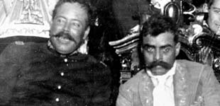Emiliano Zapata
Emiliano Zapata Salazar , called "El Caudillo del Sur", (born August 8, 1879 in San Miguel Anenecuilco ( Morelos ), † April 10, 1919 in Chinameca ) was a leading protagonist of the Mexican Revolution .
Life
Zapata was born in the village of San Miguel Anenecuilco, in the state of Morelos . His parents, Gabriel Zapata and Cleofas Salazar, were of Indian and white descent. Zapata and other farmers in Morelos took part in the campaign of the legal opposition during the election campaign for the post of governor in 1909 . In the same year, the thirty-year-old Zapata was elected President of the Defense Council ("junta de defensa") of Anenecuilco (this is a committee for the defense of the land rights of the village).
In 1910 Zapata joined the Mexican revolutionaries under the leadership of Francisco Madero . Their goal was to overthrow the Porfirio Díaz regime.
In April 1911, Zapata was elected chief of the revolutionary movement of the south. His army consisted mostly of landless farm workers . Although they were far inferior to the federal troops in terms of numbers and weapons, the revolutionaries achieved considerable success in guerrilla warfare in the mountainous state of Morelos, where they were supported by large parts of the population. In May 1911 the Zapatistas - who already had around 4,000 fighters - occupied Cuernavaca , the capital of Morelos.
The disappointment with the very slow implementation of the agrarian reform culminated in the Ayala plan , in which Madero is asked to resign and the land is to be distributed to those who work it.
The unpopular Colonel Victoriano Huerta came to power in a coup in February 1913 and Francisco Madero was murdered by the military. At that time, Zapata allied with Pancho Villa , who commanded the rebels in the north and had already set up an army against the government in Chihuahua . Soon after Huerta's fall in the spring of 1914, however, disputes arose among the revolutionary groups and their nominal commander Venustiano Carranza , who aspired to the office of president and finally prevailed against Villa's troops with the help of his military leader Alvaro Obregón . Zapata fought on for some time in the south, although Carranza's victory was already certain.
On April 9, 1919, at Carranza's instructions , Zapata was kindly invited by Colonel Jesús Guajardo to his Hacienda San Juan near Chinameca, who pretended that he wanted to join the revolutionaries. When Zapata appeared at the hacienda the following day, Guajardo's people greeted him with a hail of bullets and literally ransacked him. His body was brought to Cuautla to claim the offered reward. There the dead Zapata was publicly exhibited and finally buried. After the death of Zapata, the "Zapatistas" chose Gildardo Magaña as his successor. A few months later, the Zapatista leaders signed a support agreement with Álvaro Obregón, who meanwhile fought for power with Carranza .
reception
After Zapata's death, on the one hand, many folk tales arose , according to which Zapata was in fact able to escape his insidious murder and hid in the mountains to help the oppressed, on the other hand, he has been venerated as a martyr ever since.
In 1952 Elia Kazan filmed Zapata's life . In Viva Zapata! starred Marlon Brando . A 2004 Mexican remake by Alfonso Arau met with mixed reactions. There are also numerous other films that deal with the life or legend of the revolutionary.
The Ejército Zapatista de Liberación Nacional EZLN ("Zapatista Army of National Liberation") sees itself in the tradition of Emiliano Zapata. Hence, members of the movement call themselves Zapatistas (or Zapatista in German ). The EZLN first appeared in public on January 1, 1994 with an armed uprising and has its roots in Chiapas , one of the poorest states in Mexico . It consists mainly of indigenous people .
Quotes
"Better to die upright than live on your knees for a lifetime!"
(Original: ¡Es mejor morir de pie que vivir toda una vida de rodillas! )
Reforma - Libertad - Justicia y Ley ( Plan de Ayala , 1911)
literature
- Barbara Beck, Horst Kurnitzky : Zapata: Images from the Mexican Revolution. Wagenbach, Berlin 1978, ISBN 3-8031-2014-4 .
- Paul Hart: Emiliano Zapata: Mexico's Social Revolutionary. Oxford University Press, Oxford 2017, ISBN 978-0-19-068808-0 .
- Ralf Höller: Emiliano Zapata , in: ders., I am the fight. Rebels and revolutionaries from six centuries . Structure TB Verlag, Berlin 2001, p. 231 ff.
- Markus Kampkötter: Emiliano Zapata. From farmer's guide to legend . A biography. 2nd edition, Unrast, Münster 2002 (first edition 1996), ISBN 978-3-89771-012-2 .
- John Womack: Dying for the Indians. Zapata and the Mexican Revolution (original title: Zapata and the Mexican Revolution, Random House, New York NY 1968, translated by Eva Bänninger-Bonomo), Atlantis, Zurich / Freiburg im Breisgau 1972, ISBN 3-7611-0392-1 (Spanish: Zapata y la Revolución Mexicana , Cien de México, 24th edition, Siglo Veintiuno, México 2000, ISBN 968-23-0322-2 ); later German-language edition under the title: Land und Freiheit. Emiliano Zapata and the Mexican Revolution in Morelos 1910–1920 , Edition Julio Lopez Chavez, 1995.
Web links
- Literature by and about Emiliano Zapata in the catalog of the German National Library
- Viva Zapata! in the Internet Movie Database (English)
- Emiliano Zapata in the Internet Movie Database (English)
Individual evidence
- ↑ Fernando Díaz Díaz - Caudillos y Caciques, El Colegio de México 1972 - Enrique Krauze, El amor a la tierra, Emiliano Zapata - Fondo de Cultura Económica - Mexico DF 1987 - and ... Emiliano Zapata Wikipedia en español
| personal data | |
|---|---|
| SURNAME | Zapata, Emiliano |
| ALTERNATIVE NAMES | Zapata Salazar, Emiliano |
| BRIEF DESCRIPTION | Mexican revolutionary |
| DATE OF BIRTH | August 8, 1879 |
| PLACE OF BIRTH | San Miguel Anenecuilco , Morelos, Mexico |
| DATE OF DEATH | April 10, 1919 |
| Place of death | Chinameca |



